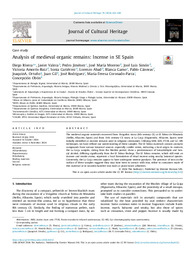Título :
Analysis of medieval organic remains: Incense in SE Spain |
Autor :
Rivera, Diego
Valera, Javier
Jiménez, Pedro
Moreno, José María
Simón, José Luis
Amorós Ruiz, Victoria
Gutiérrez, Sonia
Abad, Lorenzo
Gamo, Blanca
Cánovas, Pablo
Ortuño, Joaquín A.
Gil, Juan
Rodriguez, José
Coronado Parra, María Teresa
Obon, Concepcion  |
Editor :
Elsevier |
Departamento:
Departamentos de la UMH::Biología Aplicada |
Fecha de publicación:
2024-11 |
URI :
https://hdl.handle.net/11000/38318 |
Resumen :
The medieval organic materials recovered from Visigothic strata (8th century CE) at El Tolmo de Minateda (Hellín, Albacete, Spain) and from 11th century CE strata at La Graja (Higueruela, Albacete, Spain) were initially identified as incense remains used in religious ceremonies. Utilizing SEM, EDS, FT-IR, and GC–MS techniques, we have refined our understanding of these samples. The El Tolmo materials contain aromatic compounds from various botanical sources, especially conifer resins, indicating a local origin. In contrast, the La Graja samples, dating from the Muslim period, show a predominance of benzaldehyde and ben- zyl alcohol, differing significantly from the El Tolmo findings. The El Tolmo remains, which still emit an incense and smoke aroma, represent a local formulation of ritual incense using nearby botanical species. Conversely, the La Graja remains appear to have undergone intense pyrolysis. The presence of iron on the surface of these samples suggests they may have been in contact with iron, either in containers made of this material or in wooden-handled iron tools as plant-based adhesives.
|
Palabras clave/Materias:
Archaeobotany
Phytochemistry
Ethnobotany
Binding materials
Incense
Religious contexts |
Tipo de documento :
info:eu-repo/semantics/article |
Derechos de acceso:
info:eu-repo/semantics/openAccess |
DOI :
https://doi.org/10.1016/j.culher.2024.10.013 |
Publicado en:
Journal of Cultural Heritage 70 (2024) 422–430 |
Aparece en las colecciones:
Artículos - Biología Aplicada
|
 La licencia se describe como: Atribución-NonComercial-NoDerivada 4.0 Internacional.
La licencia se describe como: Atribución-NonComercial-NoDerivada 4.0 Internacional.
.png)
